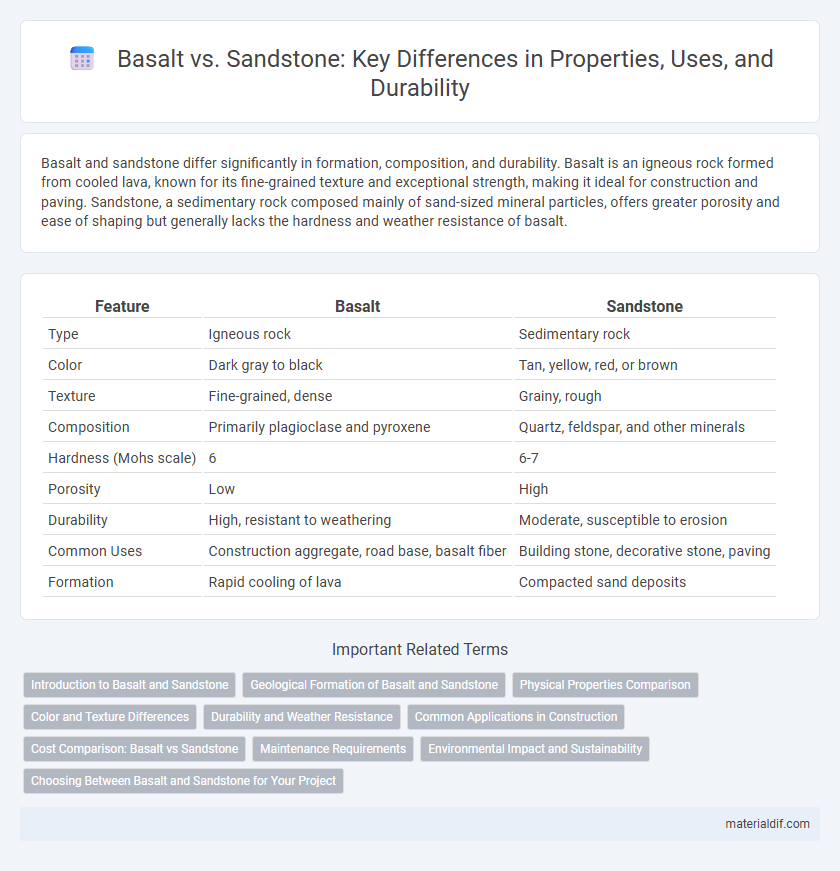Basalt and sandstone differ significantly in formation, composition, and durability. Basalt is an igneous rock formed from cooled lava, known for its fine-grained texture and exceptional strength, making it ideal for construction and paving. Sandstone, a sedimentary rock composed mainly of sand-sized mineral particles, offers greater porosity and ease of shaping but generally lacks the hardness and weather resistance of basalt.
Table of Comparison
| Feature | Basalt | Sandstone |
|---|---|---|
| Type | Igneous rock | Sedimentary rock |
| Color | Dark gray to black | Tan, yellow, red, or brown |
| Texture | Fine-grained, dense | Grainy, rough |
| Composition | Primarily plagioclase and pyroxene | Quartz, feldspar, and other minerals |
| Hardness (Mohs scale) | 6 | 6-7 |
| Porosity | Low | High |
| Durability | High, resistant to weathering | Moderate, susceptible to erosion |
| Common Uses | Construction aggregate, road base, basalt fiber | Building stone, decorative stone, paving |
| Formation | Rapid cooling of lava | Compacted sand deposits |
Introduction to Basalt and Sandstone
Basalt is a dense, fine-grained igneous rock formed from rapidly cooled lava, known for its durability and dark color, commonly used in construction and road base materials. Sandstone is a sedimentary rock composed of compacted sand-sized mineral particles, often rich in quartz, valued for its porosity and aesthetic appeal in building facades and landscaping. Both stones serve versatile roles but differ significantly in formation, texture, and typical applications within geological and architectural contexts.
Geological Formation of Basalt and Sandstone
Basalt forms through rapid cooling of molten lava at the Earth's surface, resulting in fine-grained, dense igneous rock primarily composed of plagioclase and pyroxene minerals. Sandstone is a sedimentary rock formed by the compaction and cementation of sand-sized mineral particles, predominantly quartz, deposited in diverse environments like rivers, beaches, and deserts over millions of years. The contrasting geological processes--igneous volcanic activity for basalt versus sediment deposition and lithification for sandstone--define their distinct textures and structural properties.
Physical Properties Comparison
Basalt is a dense, fine-grained igneous rock with high compressive strength and low porosity, making it highly durable and resistant to weathering. Sandstone, a sedimentary rock, has a more porous structure and is generally softer and less dense than basalt, resulting in lower mechanical strength and greater susceptibility to erosion. The physical properties of basalt make it ideal for heavy construction and abrasion-resistant surfaces, whereas sandstone is often favored for decorative applications due to its workability and varied textures.
Color and Texture Differences
Basalt is typically dark gray to black with a fine-grained, dense texture due to rapid cooling of lava, giving it a smooth and uniform surface. Sandstone varies widely in color, ranging from pale tan to reddish or brown tones, characterized by a coarse, gritty texture resulting from compacted sand grains. The contrast between basalt's consistent dark hue and fine texture and sandstone's diverse coloration and granular feel highlights their distinctive geological formation processes.
Durability and Weather Resistance
Basalt exhibits superior durability and weather resistance compared to sandstone due to its dense, fine-grained volcanic composition that resists erosion and chemical weathering. Sandstone, being a sedimentary rock with porous structure, is more susceptible to water absorption and freeze-thaw cycles, leading to quicker degradation over time. Therefore, basalt is often preferred for outdoor applications requiring long-lasting performance and minimal maintenance in harsh environmental conditions.
Common Applications in Construction
Basalt is extensively used in construction for road base materials, concrete aggregate, and railway ballast due to its high compressive strength and durability. Sandstone is commonly chosen for decorative facades, flooring, and landscaping because of its aesthetic appeal and workability. Both stones serve vital roles, with basalt favored for structural support and sandstone preferred for architectural finishes.
Cost Comparison: Basalt vs Sandstone
Basalt typically costs more than sandstone due to its higher density and durability, which translates to increased extraction and processing expenses. Sandstone remains a budget-friendly option favored for aesthetic versatility and easier workability, often priced 10-30% lower than basalt. The choice between basalt and sandstone hinges on balancing upfront material costs against long-term durability and maintenance expenses.
Maintenance Requirements
Basalt requires minimal maintenance due to its dense, hard composition, making it highly resistant to weathering and stains, ideal for high-traffic outdoor applications. Sandstone, being porous and softer, demands regular sealing and careful cleaning to prevent water absorption, staining, and erosion over time. Proper maintenance extends the lifespan of both stones, but basalt's durability significantly reduces upkeep efforts compared to sandstone.
Environmental Impact and Sustainability
Basalt exhibits a lower environmental impact compared to sandstone due to its abundant natural availability and minimal processing requirements, resulting in reduced energy consumption and carbon emissions. Sandstone extraction often involves quarrying practices that disrupt ecosystems and generate more waste, whereas basalt's durability promotes longer-lasting applications, enhancing sustainability. Utilizing basalt supports sustainable construction by minimizing resource depletion and lowering ecological footprints.
Choosing Between Basalt and Sandstone for Your Project
Basalt offers superior durability and strength, making it ideal for high-traffic or structural applications, while sandstone provides a softer, more porous texture suited for decorative or indoor uses. Understanding the geological composition and weather resistance of both stones helps optimize their use based on environmental and aesthetic requirements. Cost, maintenance, and project-specific factors should guide the choice between the dense, volcanic basalt and the sedimentary, grainy sandstone.
Basalt vs Sandstone Infographic

 materialdif.com
materialdif.com